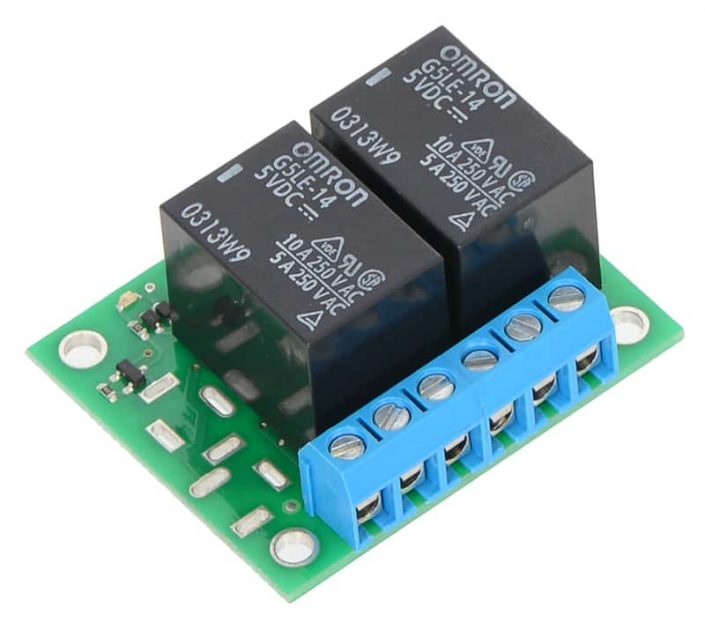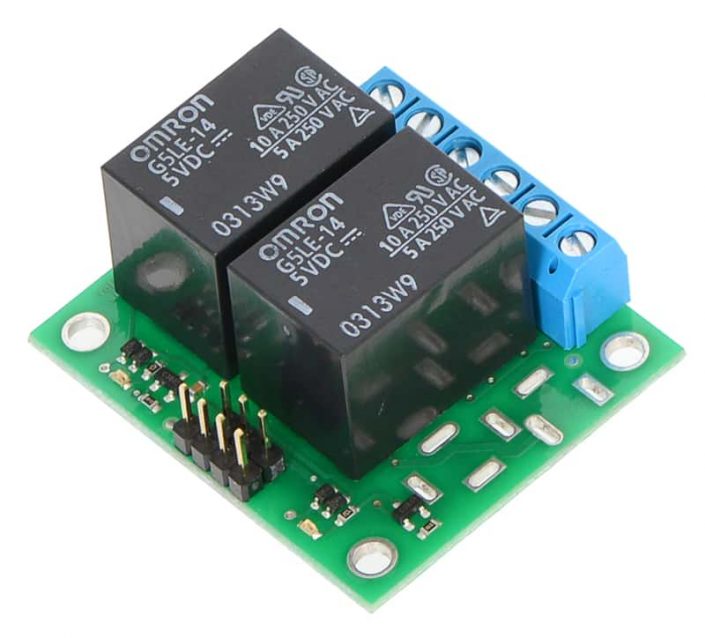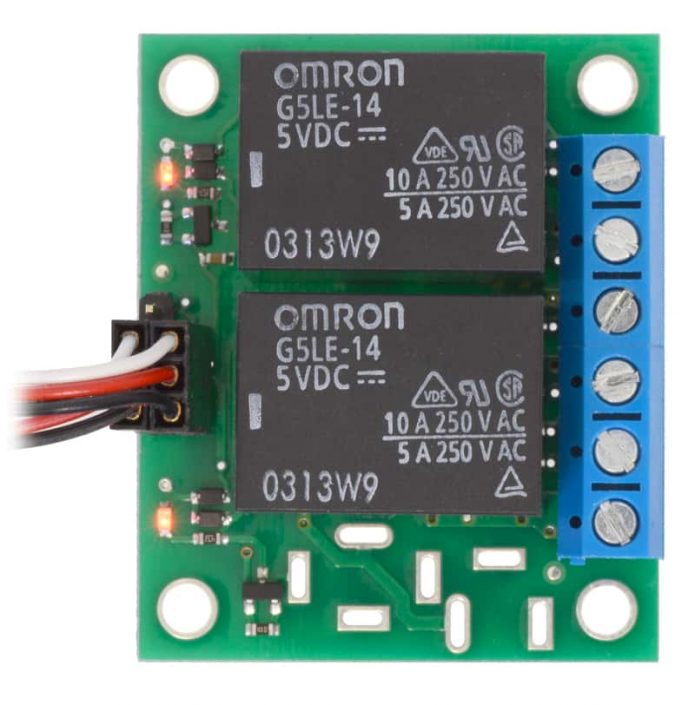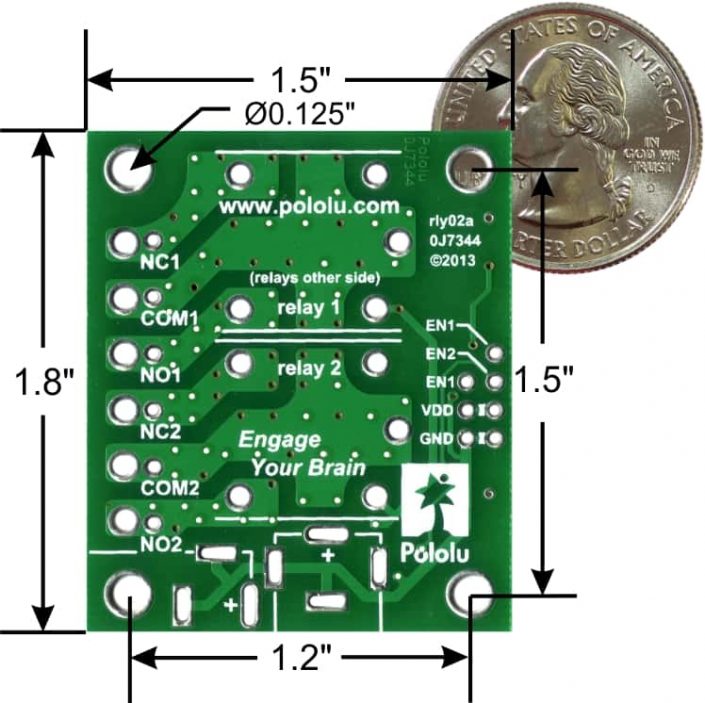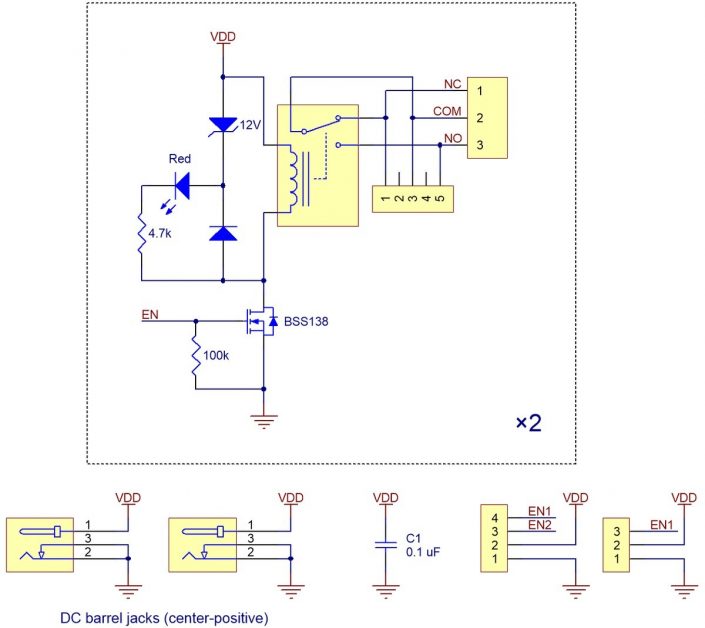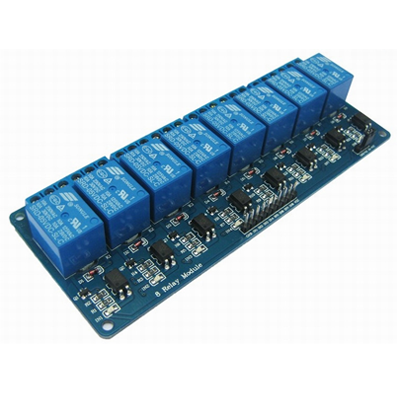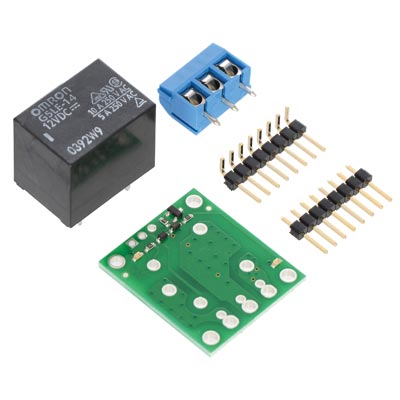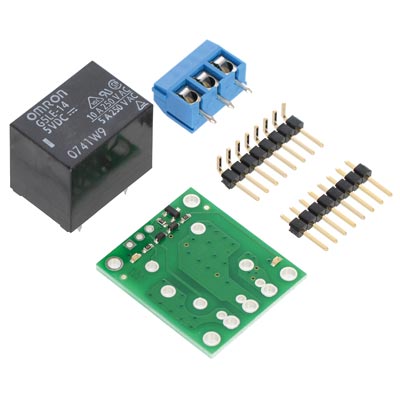Pololu Basic 2Ch SPDT Relay Carrier with 12VDC
- үнэ: 39,000 төг
Pololu Basic 2-Channel SPDT Relay Carrier with 12VDC Relays (Partial Kit)
Pololu item #: 2488
The Pololu basic 2-channel relay carrier modules allow simple, independent control of two single-pole, double-throw (SPDT) switches from low-voltage, low-current control signals. This item includes the basic carrier PCB along with two Omron G5LE-14-DC12 12 V relays, 5.0 mm terminal blocks, and 0.1" male headers in straight and right-angle versions. Surface-mount components are pre-assembled on the PCB, but the through-hole components are not installed. The included power relays are rated for up to 10 A under most conditions.
Dimensions
| Size: | 1.8″ × 1.5″ × 0.9″ |
|---|---|
| Weight: | 33 g |
Overview
The Pololu basic 2-channel relay carrier modules make it easy to control two single-pole, double-throw (SPDT) switches independently from low-voltage, low-current control signals (or you can supply the same signal to both enable lines to operate this product as a DPDT relay switch). The modules are available with 5 V and 12 V power relays—Omron G5LE-14-DC5 and G5LE-14-DC12 (1MB pdf), respectively—and they are available pre-soldered or as partial kits that allow greater application flexibility:
The carrier board routes the relay control pins to 0.1″-spaced pins compatible with standard solderless breadboads and female servo cable connectors. The assembled version of this board has all seven control pins populated with 0.1″ straight male headers while the partial kit version includes 25×1 straight and 15×1 right angle 0.1″ male header strips that can optionally be broken into pieces and soldered in. The relay switch pins are routed to a set of large pads intended for use with two 3-pin 5mm-pitch terminal blocks and a set of smaller pads with a 0.2″ pitch, making them compatible with 0.1″ perfboards. The assembled version of this board has the terminal blocks soldered to these pins while the partial kit version includes 6-pin terminal blocks that can be optionally soldered in. The carrier board has four mounting holes that work with #4 or M3 screws.
Advantages over similar products
- – Compact layout
- – LEDs to indicate coil actuation
- – Zener diodes for fast current decay on relay coils
- – Specification of electrical routing clearance rules on relay switch nodes
Using the relay modules
The switch portion of the relays are accessible on one side of the board while the control pins are routed to the other. The relay coils are powered by supplying the appropriate coil voltage for your specific relays across the VDD and GND pins, and they are activated by digital high control signals on their respective EN pins. The control signals are fed directly to the BSS138 N-channel MOSFETs, which in turn actuate the relay coils when the signal voltage exceeds approximately 2.5 V, up to a maximum of 20 V (see BSS138 datasheet (92k pdf) for details). The control pins are arranged to allow for several connection options: a single 1×4 cable can be used to supply coil power and the two control signals, or two 1×3 cables (such as servo cables) can be used side-by-side (one for each relay).
The relay switch terminals COM (common), NO (normally open), and NC (normally closed) are routed on the PCB with a minimum clearance of 60 mils (1.5 mm) from other copper and the edges of the board, though manufacturing variations in the board edges can make those distances slightly lower.
In most applications, the current and voltage ratings for the module will match the ratings of the relay used. Maximum current, maximum voltage, and life expectancy are interdependent; we therefore recommend careful examination of your relay’s datasheet.
Warning: This product is not designed to or certified for any particular high-voltage safety standard. Working with voltages above 30 V can be extremely dangerous and should only be attempted by qualified individuals with appropriate equipment and protective gear.
Optional DC barrel jack
 |
The carrier board makes it possible to optionally power the relays from a DC barrel jack (not included). The DC barrel jack can be placed in three configurations, two of which are shown in the pictures above (the jack can also be installed in one configuration on the bottom side of the PCB).
Санал болгох бараа
Үйлдвэрлэгч
Угсармал хавтан
- ЭХ ХАВТАН
- МЭДРЭГЧ модуль
- ХОЛБОЛТЫН модуль
- ИНТЕРФЕЙС хөврүүлэгч модуль
- МОТОР ДРАЙВЕР модуль
- ТЭЖЭЭЛИЙН модуль
- РЕЛЕ модуль
- Өргөтгөл модуль
- ТОВЧЛУУР модуль
- ӨСГӨГЧ, ДУУНЫ модуль
- ДЭЛГЭЦ, ЛЕД модуль
- Вольтметр, Амперметр
- RTC модуль
- AD/ DA модуль
- КАМЕР
- Програмчлагч хавтан
- EEPROM, I2C модуль
- Proto shield
- ИЖ БҮРДЭЛ
- Дагалдах хэрэгсэл
Зэс, универсал, сургалтын хавтан
- Зэс хавтан
- Универсал хавтан
- Сургалтын хавтан
Гэр ахуйн барааны хавтан
Лавлах утас: 77107805, 99198321
Хаяг : Улаанбаатар хот, Чингэлтэй дүүрэг, Компьютер ланд, 3-н давхар, 12 тоот
“ЧИП ЭЛЕКТРОНИКС” ХХК
© Copyright – 2025 www.chip.mn


